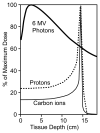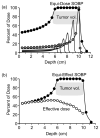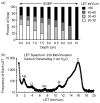Heavy charged particle radiobiology: using enhanced biological effectiveness and improved beam focusing to advance cancer therapy
- PMID: 21376738
- PMCID: PMC3101308
- DOI: 10.1016/j.mrfmmm.2011.02.012
Heavy charged particle radiobiology: using enhanced biological effectiveness and improved beam focusing to advance cancer therapy
Abstract
Ionizing radiation causes many types of DNA damage, including base damage and single- and double-strand breaks. Photons, including X-rays and γ-rays, are the most widely used type of ionizing radiation in radiobiology experiments, and in radiation cancer therapy. Charged particles, including protons and carbon ions, are seeing increased use as an alternative therapeutic modality. Although the facilities needed to produce high energy charged particle beams are more costly than photon facilities, particle therapy has shown improved cancer survival rates, reflecting more highly focused dose distributions and more severe DNA damage to tumor cells. Despite early successes of charged particle radiotherapy, there is room for further improvement, and much remains to be learned about normal and cancer cell responses to charged particle radiation.
2011 Elsevier B.V. All rights reserved.
Figures




References
-
- Muller HJ. Artificial transmutation of the gene. Science. 1927;66:84–87. - PubMed
-
- Rutherford E. Atomic Projectiles and Their Collisions with Light Atoms. Science. 1919;50:467–473. - PubMed
-
- Weber U, Kraft G. Comparison of carbon ions versus protons. Cancer J. 2009;15:325–332. - PubMed
-
- Bragg WH. On the ionization of various gases by the alpha particles of radium. No. 2. Proc Phys Soc London. 1907;20:0523–0550.
-
- DeLaney T, Kooy HM. Proton and Charged Particle Radiotherapy. Lippincott, Williams and Wilkins; Philadelphia: 2007.
Publication types
MeSH terms
Substances
Grants and funding
LinkOut - more resources
Full Text Sources

